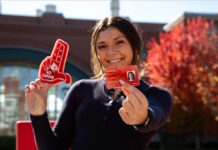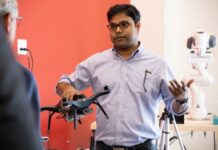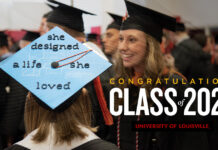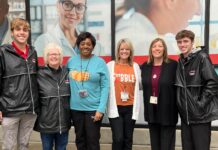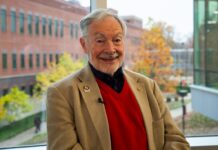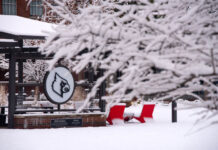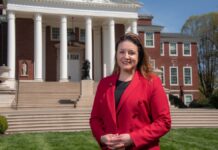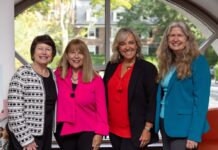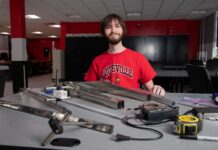Amazing things are happening at the University of Louisville. Advancements in prosthetics and synthetic and organic compounds are changing the way we think about the human body. From disease and disability to ongoing health, U of L faculty and students are exploring the augmentation of our own biology, in the hope of creating a higher quality of life for everyone.
Because of the work happening on campus, a little boy born without fingers on his hand can throw a ball. New research into synthetic compounds could one day improve oral health all over the world. And a new approach to bone replacement can help reduce healing time and discomfort from bone loss due to trauma or disease. In other words, it’s a great time to be alive.
Building a robo-hand
Lucas Abraham was born with a condition known as symbrachydatyly, leaving him with a fused radius and ulna as well as underdeveloped fingers on his right hand. And while the bright, energetic Lucas never let his disability slow him down, he would still occasionally ask his family for a “robo-hand” that would allow him to play, throw a ball and interact with the world like every other child his age. After Lucas’ grandmother sent a letter to Gina Bertocci, PhD, Bioengineering professor and Biomechanics Endowed Chair, asking for help from her and her students in the Bioengineering Department, Lucas got his wish.
Bertocci saw in the letter an opportunity not only to help Lucas, but to inspire students in her Rehabilitation Engineering course with a real-world example of what they could accomplish. Having done graduate work in rehabilitation engineering, Bertocci was well-aware of how life-changing her students’ work could be. The project would also give her students valuable experience in 3-D printing, rapid prototyping and computer-aided engineering.
“I like to choose projects that let students see their impact,” said Bertocci. “I want them to be able to demonstrate what they’ve learned in my class, and from their entire bioengineering and rehabilitation engineering curriculum.”
For Lucas’ project, Bertocci divided her class of 15 into groups of five. Each group was to pursue a different design, with the ultimate goal of giving Lucas increased functionality.
To make sure the robo-hand would be a perfect fit, Bertocci’s students made a plaster mold of Lucas’ hand. These molds were then scanned into a computer as a “point cloud,” a collection of data points that can be used to create and manipulate a three-dimensional object in computer-aided drafting and engineering software.
“The students did most of their preliminary work on the computer,” said Bertocci. “By working in a virtual environment, they were able to create designs that were guaranteed to fit and interface with Lucas’ hand, wrist and forearm.”
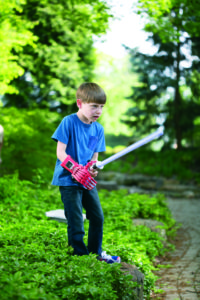
Once the designs were finished and properly tested in a virtual environment, it was time to make them a reality. The most efficient way to do this was by printing the designs on a 3-D printer, a process that took between 20 and 30 hours per hand. Another 12 hours were spent assembling each of the three hands. This process wasn’t as simple as just snapping pegs into holes, though.
“The components of each hand were joined together by cables, wires and other structures that would replicate the function of the tendons in a human hand,” said Bertocci. “The students were also very careful in creating the interface between Lucas and his hand. We didn’t want it to ever cause him any discomfort or abrasion, even with prolonged use. Yet it had to be durable enough to withstand all the things that kids like to do.”
“On the day of the presentations, Lucas was accompanied by his parents and his grandmother,” said Bertocci. “It was amazing. He tried on the hands, the students made minor adjustments, and within 10 minutes he was picking up a ball.” Each of the three hands operates in basically the same fashion. When Lucas bends his wrist up and down, cables on his new hands cause the fingers to grasp and release.
Lucas had the final say in which hand would be his. While Lucas liked all three hands, one had to be retained by the school for accreditation documentation. Of the two that Lucas took home with him, one is reminiscent of Spider-Man, while the other hand is green, glows in the dark and has a light built into it.
The new hand was an immediate hit with Lucas’ classmates as well. Rather than becoming an object of curiosity, Lucas was embraced as a celebrity by his peers.
“His classmates swarmed him,” said Bertocci. “They all wanted to be like Lucas. Whenever you are able to help someone with a disability integrate seamlessly into society, that’s a success. That’s what we strive for.”
The Office of Tech Transfer helps new ideas become successful
While Lucas’ hand was developed using open-source resources, many accomplishments and discoveries at UofL present the opportunity for profit. To help the university, its faculty and its students turn their discoveries into marketable products, the Office of Tech Transfer helps coordinate the patenting and licensing of promising technology.
Two discoveries that are currently enjoying assistance from the Office of Tech Transfer have the potential to change health in two different ways.
And both show enormous possibility.
Discovering a method for faster bone replacement and shorter recovery times
Bone voids are areas in the body where bone has been removed, lost or destroyed either by surgery, disease or trauma. The current procedure for replacing lost bone is to fill in the void with a calcium-based synthetic material. Over time, this synthetic material is slowly reabsorbed into the body and replaced with living bone.
Unfortunately, physicians treating patients with bone loss must decide between healing and mobility or biology versus strength. Current synthetic bone graft substitutes are either strong, allowing the patient to resume normal activities quickly, or they are fast-absorbing, which permit the body to replace the material with bone at a more rapid rate.
Michael Voor, PhD, associate professor of orthopaedic surgery and bioengineering and founder of the Orthopaedic Bioengineering Laboratory at the School of Medicine, has a better idea.
Voor’s creation, known as Trabexus EB, is strong enough to allow patients to get back on their feet more quickly, yet is absorbed more rapidly by the body and turned into new living replacement bone. Trabexus EB is based on a self-hardening cement made of calcium phosphate, but uses allograft made from donor bones to add more organic material to the mixture.
During the course of his research, Voor has found the ideal ratio of calcium phosphate to bone particles to optimize healing and replacement, while still providing plenty of strength to support movement, anchor screws and aid in bearing weight.
“It’s so similar to bone that the body recognizes it as the real thing,” said Voor. “Since the body sees it as bone, it replaces it with living bone fairly rapidly. And since remodeling happens quickly, surgeons no longer have to decide between mechanical strength and bone replacement.”
In fact, Trabexus EB is strong enough that, in many applications it has the potential to reduce the number of plates, screws and other hardware that surgeons typically use to support bones as they heal.
Trabexus EB is flexible in its applications, as well. It can be mixed and applied with a large syringe, allowing surgeons to fill bone cavities through a small opening. It can also be molded and sculpted by hand before it hardens to fill larger, more accessible areas of bone loss.
To help market Trabexus EB, Voor has created a company known as Vivorte. He is currently licensing Trabexus EB from the university for Vivorte’s use, with the assistance of the Office of Tech Transfer.
A new compound could make gum disease a thing of the past
Donald Demuth, PhD, associate dean for research and enterprise, School of Dentistry, and Frederick Luzzio, PhD, professor, College of Arts and Sciences Department of Chemistry, have developed a synthetic biochemical that can actually inhibit gum disease.
Gum disease begins when the bacteria P. gingivalis comes in contact with the bacteria S. gordonii. The two adhere together, and P. gingivalis begins to attack oral tissue and make its way below the gum line. This leads not only to inflammation in the mouth, but also to inflammation in other parts of the body.
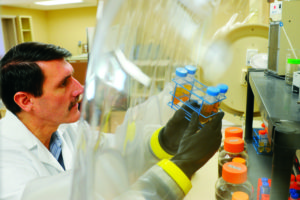
Several years ago, Demuth discovered a peptide that, when applied to the mouth, could actually prevent P. gingivalis and S. gordonii from adhering together. This effectively defeated gum disease before it had a chance to start. The peptide was even effective at eliminating gum disease that had already developed.
“Unfortunately,” said Demuth, “peptides are expensive and hard to formulate. So I sought out Dr. Luzzio, who has extensive experience creating synthetic molecules used as anti-cancer drugs.” Together, Demuth and Luzzio developed a synthetic version of Demuth’s peptide that is just as effective at preventing P. gingivalis from adhering to S. gordonii. So together, these two researchers may change oral health forever.
The peptide and synthetic compound are both currently patented, and are being marketed to the private sector with the help of the University of Louisville Office of Tech Transfer.
For more stories from the Summer 2016 issue, visit louisville.edu/uoflmagazine.


